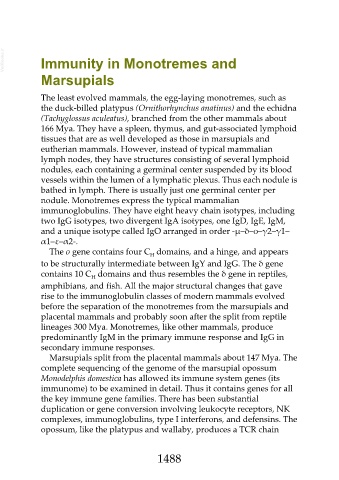Page 1488 - Veterinary Immunology, 10th Edition
P. 1488
VetBooks.ir Immunity in Monotremes and
Marsupials
The least evolved mammals, the egg-laying monotremes, such as
the duck-billed platypus (Ornithorhynchus anatinus) and the echidna
(Tachyglossus aculeatus), branched from the other mammals about
166 Mya. They have a spleen, thymus, and gut-associated lymphoid
tissues that are as well developed as those in marsupials and
eutherian mammals. However, instead of typical mammalian
lymph nodes, they have structures consisting of several lymphoid
nodules, each containing a germinal center suspended by its blood
vessels within the lumen of a lymphatic plexus. Thus each nodule is
bathed in lymph. There is usually just one germinal center per
nodule. Monotremes express the typical mammalian
immunoglobulins. They have eight heavy chain isotypes, including
two IgG isotypes, two divergent IgA isotypes, one IgD, IgE, IgM,
and a unique isotype called IgO arranged in order -µ–δ–ο–γ2–γ1–
α1–ε–α2-.
The ο gene contains four C domains, and a hinge, and appears
H
to be structurally intermediate between IgY and IgG. The δ gene
contains 10 C domains and thus resembles the δ gene in reptiles,
H
amphibians, and fish. All the major structural changes that gave
rise to the immunoglobulin classes of modern mammals evolved
before the separation of the monotremes from the marsupials and
placental mammals and probably soon after the split from reptile
lineages 300 Mya. Monotremes, like other mammals, produce
predominantly IgM in the primary immune response and IgG in
secondary immune responses.
Marsupials split from the placental mammals about 147 Mya. The
complete sequencing of the genome of the marsupial opossum
Monodelphis domestica has allowed its immune system genes (its
immunome) to be examined in detail. Thus it contains genes for all
the key immune gene families. There has been substantial
duplication or gene conversion involving leukocyte receptors, NK
complexes, immunoglobulins, type I interferons, and defensins. The
opossum, like the platypus and wallaby, produces a TCR chain
1488

